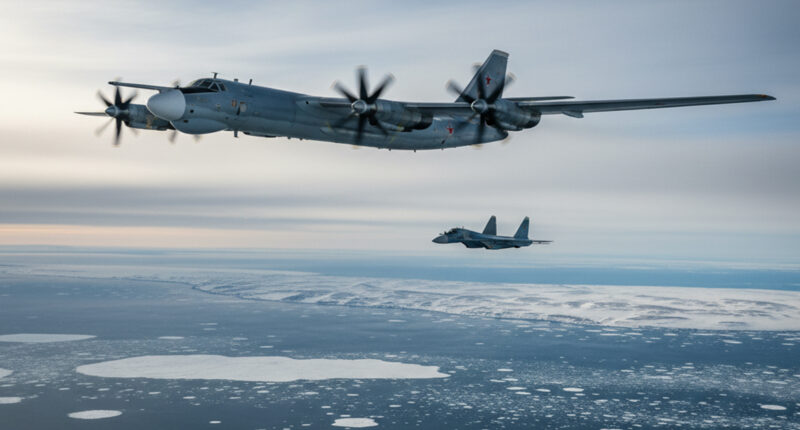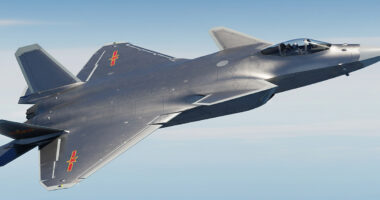The vast, icy expanse above the Barents Sea and the distant, often turbulent waters of the Sea of Okhotsk recently served as a stage for a significant display of military presence. On September 25, the Russian Defense Ministry confirmed that its formidable Tu-95MS long-range strategic bombers had successfully completed a planned patrol mission over the international airspace of these critical maritime regions. This was no ordinary flight; lasting over 14 hours and escorted by nimble Su-35S and Su-30SM fighter jets, the mission underscored Russia’s persistent assertion of its military capabilities and strategic reach, prompting responses from international defense organizations.
This latest development, while seemingly routine to Moscow, sends ripples through global security circles. Such patrols are a recurring feature of geopolitical dynamics, each time sparking scrutiny and a reminder of the delicate balance of power in sensitive regions.
The Anatomy of a Strategic Patrol: Tu-95MS and its Escorts
The protagonists of this aerial ballet are the Tu-95MS bombers, known by their NATO reporting name “Bear.” These turboprop-powered giants are an enduring symbol of Soviet-era engineering, first introduced in the mid-1950s, yet continually modernized to remain relevant in contemporary warfare. Designed primarily as missile carriers capable of delivering long-range cruise missiles, the Tu-95MS aircraft are crucial assets in Russia’s strategic bomber fleet. Their extended range and payload capacity make them ideal for prolonged patrol missions far from Russian shores, projecting power and collecting intelligence.
Accompanying these lumbering giants were advanced fighter jets: the Su-35S and Su-30SM. The Su-35S, a highly maneuverable “4++ generation” multirole fighter, provides formidable air superiority capabilities, while the Su-30SM, a two-seat supermaneuverable fighter, offers versatility for air-to-air and air-to-ground missions. Their presence is vital, offering protection against potential interceptions and demonstrating Russia’s capacity to conduct complex, coordinated aerial operations.
The Russian Defense Ministry’s statement explicitly mentioned that “in some areas of the patrol mission, foreign fighter jets also accompanied the Russian aircraft.” This seemingly understated detail is highly significant. It confirms the standard protocol of international airspace interceptions, where sovereign nations deploy their own aircraft to shadow and identify foreign military planes operating near their Air Defense Identification Zones (ADIZ). This is a dance of observation, a silent communication of vigilance without direct engagement.
NORAD’s Vigilant Eye: Detecting and Tracking
True to form, the North American Aerospace Defense Command (NORAD) provided the other side of the story. On September 25, NORAD reported detecting four Russian military aircraft near Alaska on September 24. Specifically, two Tu-95 bombers and two Su-35 fighter jets were identified within the Alaska Air Defense Identification Zone (ADIZ).
NORAD’s response highlights the critical role of these international organizations. Their statement was carefully worded: “The Russian aircraft remained in international airspace and did not enter American or Canadian sovereign airspace,” and critically, “the Russian activity is routine and is not considered a threat.” This clarification is essential. While the presence of foreign military aircraft near an ADIZ always triggers a response, the distinction between “international airspace” and “sovereign airspace” is paramount in avoiding escalation. It underscores that Russia, while demonstrating its capabilities, operated within the bounds of international law.
The Significance of the ADIZ
Understanding the concept of an Air Defense Identification Zone (ADIZ) is key to comprehending these events. An ADIZ is not sovereign airspace; it’s an area of international airspace extending beyond a country’s national borders where civilian and military aircraft are requested to identify themselves for air defense purposes. While there’s no universally recognized international law governing ADIZs, many nations maintain them as a measure of national security. When foreign military aircraft enter an ADIZ, it’s a signal for the host nation to increase vigilance, often scrambling its own jets to monitor the situation. NORAD’s repeated detection of Russian aircraft in the Alaskan ADIZ is a testament to its continuous monitoring efforts in a strategically vital region.
A Recurring Pattern: The “Ninth Time This Year”
What makes this particular incident particularly noteworthy, beyond the immediate details, is its frequency. NORAD’s website confirmed that “this is the ninth time this year that NORAD has reported similar incidents involving Russian aircraft flying near Alaska.” This statistic paints a clear picture: these are not isolated events but a consistent, deliberate pattern of activity by the Russian military.
This regularity serves several purposes for Russia:
- Training and Readiness: Such long-duration flights over challenging environments like the Barents and Okhotsk Seas are invaluable for training aircrews, testing equipment, and maintaining operational readiness of both bomber and fighter fleets.
- Projection of Power: By routinely flying these missions, Russia demonstrates its capacity to operate strategic assets far from its main bases, asserting its status as a major military power with global reach.
- Intelligence Gathering: While not explicitly stated, these missions likely involve intelligence gathering, surveying foreign military installations, ship movements, and radar signatures.
- Testing Response Times: Every time Russian aircraft approach an ADIZ, it prompts a response from the host nation. This allows Russia to gauge the readiness and reaction times of opposing air forces.
- Political Signaling: In an era of heightened geopolitical tensions, these flights serve as a powerful political signal to NATO, the United States, and its allies, indicating Russia’s unwillingness to cede dominance in its perceived spheres of influence.
Geopolitical Implications and Future Outlook
The regions involved – the Barents Sea and the Sea of Okhotsk – are of immense strategic importance. The Barents Sea, bordering the Arctic, is crucial for Russia’s Northern Fleet and its nuclear submarine ballistic missile bases. Control and presence here are vital for its second-strike capability. The Sea of Okhotsk, on Russia’s far eastern flank, provides access to the Pacific and is integral to its Pacific Fleet. Both areas are gateways to vast resource reserves and critical maritime routes.
These recurring patrols highlight the ongoing great power competition. While NORAD classifies these activities as “routine” and “not a threat” in terms of immediate danger, they undeniably contribute to a persistent state of vigilance and a subtle but continuous assertion of presence. They represent a complex interaction where nations test boundaries, observe responses, and reaffirm their capabilities without engaging in direct conflict.
As long as geopolitical tensions persist and global powers seek to maintain their strategic influence, we can expect these aerial ballets to continue. The sight of Tu-95MS bombers, even when flying within international norms, will remain a potent symbol of military strength and a constant reminder of the intricate and ever-evolving landscape of global security.









